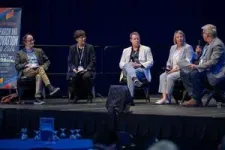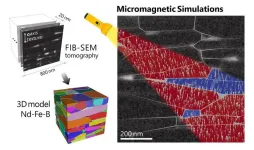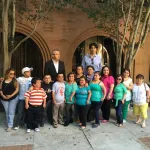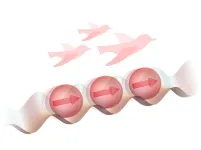(Press-News.org) NEWPORT NEWS, VA – On April 18, the U.S. Department of Energy’s Thomas Jefferson National Accelerator Facility welcomed Under Secretary for Science and Innovation Geraldine (Geri) Richmond for a tour of the lab and briefing on its research mission, innovation and STEM programs.
Throughout the day, much of the conversation centered on a common theme of how the lab is working to ensure it is a hub of engagement, partnership, and access for researchers, students, community leaders and others. Ensuring diverse communities have access to the programs, support and opportunities offered by DOE and its national labs is a key priority for the lab and its future.
“Jefferson Lab, along with all of the DOE National Labs and the Office of Science, is working hard to diversify its research portfolio to better include historically underrepresented institutions and researchers,” said Richmond.
The day started with meetings with on-site DOE staff. Jefferson Lab Director Stuart Henderson then gave a brief introduction to the lab, its mission and research.
“Our long-term mission is to advance our understanding of the building blocks of matter, and that’s recently been joined by a new focus on high performance computing and data science,” Henderson said. “As we move forward into the future, we intend to deliver on these priorities with steadfastness but also agility. And we will also continue to share our innovations to benefit the nation, our passion for educating the next generation, and our desire to positively impact our region’s economy.”
Later, the visit turned to discuss highlights of individual programs and initiatives that support the lab’s mission. One highlight focused on the many programs the lab offers to students and educators to ensure these key groups benefit from the knowledge, expertise and support the national labs have to offer. Another discussion centered on artificial intelligence, machine learning and computing resources, including the new High Performance Data Facility (HPDF) project that is currently in the conceptual design phase.
“HPDF is a partnership between Jefferson lab and Lawrence Berkeley National Lab, and we've set the whole project up like that,” said Jefferson Lab Deputy Director for Science David Dean. “HPDF represents a unique opportunity to transform and accelerate scientific discoveries and innovation by providing a seamless data life cycle to users across Office of Science experimental and computational facilities. I believe HPDF will be a game changer in the way we perform science.”
Updates on projects being pursued by the lab’s Biomedical Research & Innovation Center focused on how BRIC members and their projects are jump-starting conversations with those in the medical and biomedical fields to ensure key nuclear physics technologies are being applied to significant challenges these fields face.
Another discussion centered on the many partnership efforts the lab has recently undertaken to bring together community and business leaders with lab and energy representatives to discuss ways that these groups can work together to benefit our local communities and the nation. Ensuring these groups are aware of opportunities to engage in DOE programs and have access to those programs to support their work can lead to real-world, innovative solutions to problems in energy, coastal and environmental challenges with local impacts.
“Legislation signed by President Biden, the Bipartisan Infrastructure Law and Inflation Reduction Act, is sending a once-in-a-generation amount of investment into communities to improve infrastructure, address climate change, and create jobs,” Richmond said. “Our DOE Laboratories can serve as community advisers to help make sure these investments are going where they are most needed.”
Also during the visit, a short tour of the lab began with a trip to the control room of the lab’s world-leading particle accelerator, the Continuous Electron Beam Accelerator Facility. Led by the group leader for the Machine Control Center, Paul Vasilauskis, the delegation entered the control room to watch as CEBAF’s accelerator operators delivered electron beams to three of CEBAF’s four experimental halls for experiments. CEBAF is a DOE user facility that supports the research of more than 1,900 nuclear physicists worldwide.
The second stop on the tour featured the lab’s Experimental Hall D. There, Hall D Leader Eugene Chudakov focused on the physics mission of the lab. Hall D features the GlueX detector systems, which are enabling a new understanding of the force that glues together the building block of matter, protons and neutrons, in the nucleus of the atom.
On the last stop, Under Secretary Richmond and guests visited the Institute for Superconducting Radiofrequency Science and Technology. There, SRF Science and Technology Department Head Rongli Geng and Accelerator Physicist Anne-Marie Valente-Feliciano showed off the lab’s recent gains in unlocking the secrets of superconductivity in SRF materials and several large particle accelerator sections under assembly.
Click here for photo highlights from the visit.
-end-
Jefferson Science Associates, LLC, manages and operates the Thomas Jefferson National Accelerator Facility, or Jefferson Lab, for the U.S. Department of Energy's Office of Science.
DOE’s Office of Science is the single largest supporter of basic research in the physical sciences in the United States and is working to address some of the most pressing challenges of our time. For more information, visit https://energy.gov/science.
END
Hundreds of faculty, students and business leaders flocked to The University of Texas at Arlington for its second annual Research and Innovation Expo, an event designed to showcase the University’s research efforts.
“This is an event where we can showcase our research achievements and encourage everyone to learn about and engage with other investigators outside their own fields,” said Eileen Clements, interim executive director of the UT Arlington Research Institute and an organizer of the event.
Researchers learned how ...
By Leah Shaffer
A new imaging technique developed by engineers at Washington University in St. Louis can give scientists a much closer look at fibril assemblies, stacks of peptides like amyloid beta, most notably associated with Alzheimer’s disease.
These cross-β fibril assemblies are also useful building blocks within designer biomaterials for medical applications, but their resemblance to their amyloid beta cousins, whose tangles are a symptom of neurodegenerative disease, is concerning. Researchers want ...
The University of Texas MD Anderson Cancer Center and RUSH University System for Health today announced a partnership to create RUSH MD Anderson Cancer Center. The partnership represents advanced clinical and operational integration in the delivery of cancer care, providing RUSH patients greater access to cancer treatments and research considered among the best in the world.
MD Anderson is one of the nation’s leading cancer centers and its team of experts is devoted exclusively to cancer patient care, research, education ...
1. NIMS has succeeded in simulating the magnetization reversal of Nd-Fe-B magnets using large-scale finite element models constructed based on tomographic data obtained by electron microscopy. Such simulations have shed light on microstructural features that hinder the coercivity, which quantifies a magnet’s resistance to demagnetization in opposing magnetic fields. New tomography-based models are expected to guide toward the development of sustainable permanent magnets with ultimate performance.
2. Green power generation, electric transportation, and other high-tech industries rely heavily on ...
A new study highlights possible cardiovascular health advantages in individuals with a rare condition known as growth hormone receptor deficiency (GHRD), also called Laron syndrome.
GHRD, which is characterized by the body’s impaired ability to use its own growth hormone and results in stunted growth, has been linked in mice to a record 40% longevity extension and lower risks for various age-related diseases. However, the risk of cardiovascular disease in individuals with GHRD has remained ...
When did you last go anywhere without your cell phone? From maps and weather apps to social media platforms, we give consent for our phones to trace our footsteps and behavior. These curated mobility data are often used for personalized advertisements. In a commentary, published April 26 in the journal Cell Reports Sustainability, scientists argue mobility data can offer so much more—it is key to understanding human-wildlife interactions for guiding policy decisions on sustainability-related issues and should be free and accessible for research.
As ...
Are mice clever enough to be strategic?
Kishore Kuchibhotla, a Johns Hopkins University neuroscientist who studies learning in humans and animals, and who has long worked with mice, wondered why rodents often performed poorly in tests when they knew how to perform well. With a simple experiment, and by acting as “a little bit of a mouse psychologist,” he and his team figured it out.
“It appears that a big part of this gap between knowledge and performance is that the animal is engaging in a form of ...
Researchers Kazuaki Takasan and Kyogo Kawaguchi of the University of Tokyo with Kyosuke Adachi of RIKEN, Japan's largest comprehensive research institution, have demonstrated that ferromagnetism, an ordered state of atoms, can be induced by increasing particle motility and that repulsive forces between atoms are sufficient to maintain it. The discovery not only extends the concept of active matter to quantum systems but also contributes to the development of novel technologies that rely on the magnetic ...
About The Study: The findings of this study of 26,000 participants from four large U.S. studies suggest that both individual- and area-level social determinants of health may be considered in future development of atherosclerotic cardiovascular disease risk assessment tools, particularly among Black individuals.
Authors: Yiyi Zhang, Ph.D., of Columbia University Medical Center in New York, is the corresponding author.
To access the embargoed study: Visit our For The Media website at this link https://media.jamanetwork.com/
(doi:10.1001/jamanetworkopen.2024.8584)
Editor’s ...
One injected dose of an experimental malaria monoclonal antibody was 77% effective against malaria disease in children in Mali during the country’s six-month malaria season, according to the results of a mid-stage clinical trial. The trial assessed an investigational monoclonal antibody developed by scientists at the National Institutes of Health (NIH), and results appear in The New England Journal of Medicine.
“A long-acting monoclonal antibody delivered at a single health care visit that rapidly provides high-level protection against malaria in these vulnerable populations would fulfill an unmet public health need,” said Dr. Jeanne ...









